Anyone who knows anything about prepping knows that building a survival pantry or stockpile is a big part of prepping. For most of us, that’s where we started, and no matter how long we’ve been at it, we’re probably still adding to it. That can cause problems at times, both in trying to find places to put all the food and trying to keep track of what we have in our pantry.
As anyone who has had trouble finding something can tell you, not being able to find it is just about as bad as not having it at all. When push comes to shove, you may not remember what you have and you won’t really have time to go searching for it. Your stockpile needs to be well organized and easy to work with.
That doesn’t preclude the need to split your stockpile up though. There’s always the possibility of a home invasion, so you need to have your food split up and stored in different parts of your home. That just adds to the challenge of organizing your pantry to make it usable.
There are always things you can do to make your prepper pantry better. So just like continually adding to it, you should also be continually improving it. Taking the time to do these things now will surely make it better for you, when the time comes that you actually have to eat the food in your pantry.
Develop a Printed Inventory
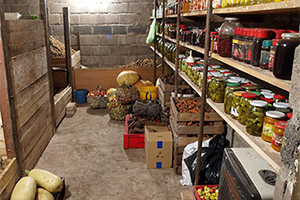 Taking the time to develop a printed inventory of what you have in your pantry and put it in a notebook is a great idea. But don’t just put quantities of items; write down where you’ve got each of those things stashed away.
Taking the time to develop a printed inventory of what you have in your pantry and put it in a notebook is a great idea. But don’t just put quantities of items; write down where you’ve got each of those things stashed away.
If you’re doing it right, you’ll split each item up, so you’ll need to note each location you’ve put it in, as well as how much you have in that location.
The first thing you’ll notice, if you do this, is that you have more of some things than you thought you do and less of others. So the first benefit you’re going to get out of your inventory is a chance to rectify those shortages. Make sure you amend your count, when you put the new items away, so that your inventory stays accurate.
When the time comes, that inventory will help you with meal planning, as well as finding where you put everything, saving time and hassles. Just make sure that you update the inventory as you use things, so that you’ll always have an accurate count of what you’ve got.
Building a Survival Recipe Book
Speaking of your inventory; do you have recipes you can cook with that food? Surprisingly, most of the people I talk to, don’t. They just assume that they can cook whatever they have. But unless your stockpile is made up of just canned goods, you’re going to have to do some actual cooking. Not only that, but you’re going to be cooking over a fire, not like you’re used to.
You’re either going to need totally different recipes than you’re used to using, or to find ways of modifying the recipes you’re using, so as to cook them with the methods and foodstuffs you’ll have available to you. It would be a good idea to try those modifications now, just to make sure that they’ll work, without wasting food when your supplies are limited.
In addition to that, there’s a good chance that you’re going to have to doctor up some recipes, adding spices to them, in order to get your family to eat them. Once again, it’s better to figure that out now, while it doesn’t hurt you to throw away food that doesn’t turn out right, than to wait until you can’t afford to throw it away.
Related: 15 Reasons to Add 4lb Of Lard to Your SHTF Stockpile
Automatic Stock Rotators for Canned Goods
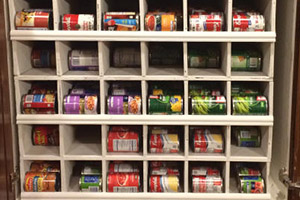 There are two basic philosophies for your prepping pantry; either having a stockpile of food that is separate from you regular pantry and is left undisturbed until a crisis, or integrating your prepping stock with your day-to-day food usage and rotating your food stock.
There are two basic philosophies for your prepping pantry; either having a stockpile of food that is separate from you regular pantry and is left undisturbed until a crisis, or integrating your prepping stock with your day-to-day food usage and rotating your food stock.
Rotating your stock is a great idea, if you can. But rotating your stock can be a big hassle, requiring that you empty out your shelves, so that you can put the newer items in back of the older ones. The easy solution to this is to make racks that allow you to put the new inventory in behind the old, without having to move the old.
The easy way to do this, especially with canned goods, is to build racks that the cans can roll down. I’ve seen a number of different configurations of these, from ones that hang on the wall to entire racks which can hold dozens of different types of food.
Regardless of how they are physically configured, you load the new cans into the rack from the back or top, and those cans roll down the track until they meet the existing stock. When you need to take a can, you do so from the front of the rack, where the oldest can will automatically be.
The same idea can be used with boxed goods as well, although that isn’t quite so easy. But doing it with boxed goods will help ensure that your food stockpile is as fresh as possible, as you are constantly replacing the old food with new.
Related: Remove This From Your Stockpile Immediately
Underbed Storage
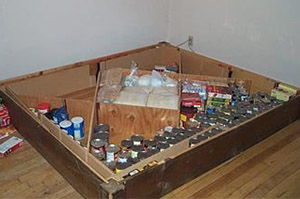 One of the least utilized storage areas in most homes is under the beds. While most people have something stored under the bed, it’s not much, not well organized and certainly not taking up all the available space.
One of the least utilized storage areas in most homes is under the beds. While most people have something stored under the bed, it’s not much, not well organized and certainly not taking up all the available space.
What makes this even worse is that box springs no longer exist. If you buy a mattress and “box” now, that’s literally what you get; a box. Look in the bottom of it and you’ll see that it’s empty. All that space is going to waste.
All you need to do is build a box that will take up the space underneath the bed and that taken up by the now empty box springs. It can either replace the existing bed frame or if you have a fancy bed frame, it can be put just inside the frame. Put a hinged platform on top of it, with the hinge at the head of the bed and some prop rods to hold it up. Then fill up the space with food, making sure you annotate your inventory with what’s in there.
Putting In a Water Cistern
Water is probably the hardest thing to stockpile, mostly because we need so much of it. It’s hard to find enough space in your home to fit enough water to last very long. Filling your basement with blue plastic barrels might be one solution, but most of us need that space for other things as well.
⇒ The Awesome DIY Device That Turns Air Into Fresh Water
One of the easiest ways to store a lot of water is with a swimming pool. You can buy a decent above-ground pool for a few hundred dollars. That will allow you to store a lot of water, without taking up space that you need for other things. Not only that, but caring for the pool and adding chlorine regularly will keep the water clean and safe to drink. Your neighbors won’t even know that it’s a cistern.
So, how much water can you store in an above-ground pool? That depends on the size of the pool. A 12 foot diameter pool, 30 inches deep will hold about 2,100 gallons of water. One that’s 16 feet in diameter and three feet deep will hold 4,500 gallons.
You Need Some Survival Caches
One of the more important and commonly overlooked needs for any prepping pantry is to have remote caches of food for use in an emergency. Any preppers living in Paradise, California lost their entire stockpile, when their town burnt to the ground in November of 2018. While the town had evacuated and the residents were safe, I’m sure that there were some of them who were short on cash and wished they had some food stashed away in a cache somewhere.
Remote survival caches can be located near or far, just as long as they are in places which make sense for your overall survival plan. It is better to have several of them, rather than just one big one. While it might be a hassle to go retrieve that food in the midst of a crisis, having it located away from your home may also be just the thing that helps you to survive.
There are many ways of making a cache, including storing food at relatives and friends houses, or renting a small storage “mini-warehouse”. You can also bury food underground. Five-gallon buckets are great for this, as they are moisture-proof and sturdy enough that rodents and insects can’t eat their way through. Just be sure to pick good landmarks for anything you bury, so that you’ll be able to find it again.
You may also like:
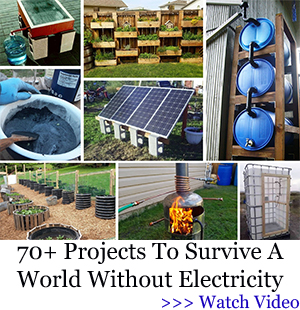 How to Keep Moisture and Pests Away from Your Food Stockpile
How to Keep Moisture and Pests Away from Your Food Stockpile
Backyard Projects That Might Get You Arrested (Video)
22 Cans You Can Purchase for $1 or Under

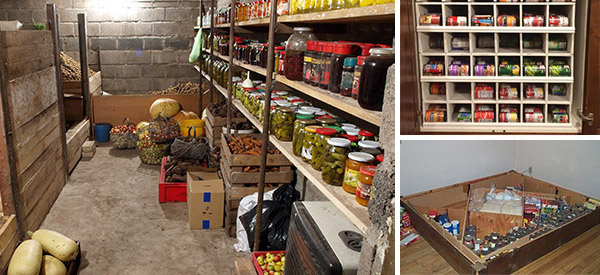













Very good information. Makes you consider things you make not have prior.
I use IB’C’s for water storage. 300+ gallons per container.
Chuck: Due to old age, my brain cells are not fully operational yet this morning. Need another cup of coffee. Just what is an IBC?
Well for those readers like me who did not know what an IBC was, it stands for Intermediate Bulk Carrier and they come in two basic sizes 275 gallons and 330 gallons. A 330 gallon IBC occupies a full pallet according to what I read.
That means in order to move the IBC, once it is off the truck tailgate, you would need a pallet jack to move it to your back yard or any place other than where the truck driver dumped it after delivery unless you paid extra for special inside delivery.
OR if you have four or six large sized sons who could move it, it would be no problem until full.
I didn’t price them as that is just too much to contemplate for me. I would prefer a wading pool and cover to preserve water if I were going to go for bulk water. I suspect on sale at WallyWorld at the end of summer, you can pick up a wading pool for a fairly small sum of money. I picked up small ones about four feet in diameter for less than $5.00 each a couple of years ago which I use to collect rain water on those rare occasions that we actually have precipitation fall out here.
We used to call them “gaylord” containers.
Even a mild earthquake will send all those jars on the floor. Open shelves are a disaster waiting to happen.
Earthquakes are not an issue in all areas.
New Jersey and New York City have had earthquakes recently. Not where you’d expect to have them! There are fault lines running all through our continental plate!
some one posted “Earthquakes are not an issue in all areas”
True, until you have one !!!
Earthquakes are like wildfires. One can never tell what damage will ensue. The, at that time, Ventura County Sheriff told me during the Northridge Earthquake sometime in the 1990s, he had several gun safes in his garage filled with rifles. He also had numerous paint cans on shelves in that same garage. After the earthquake he dreaded going in his garage because he envisioned that all the paint cans would be on the floor and that many of them would have opened upon impact and spilled gallons of paint on his garage floor.
To his utter amazement, his gun safes had fallen over and in some cases had moved completely across the garage floor, but not one paint can had fallen from the shelving.
Go figure.
He also said it was a real chore getting those gun safes, most of which had fallen on the door, back upright so that they could see if the rifles were damaged and to get the safes back in position.
This is not to suggest that PNJ is incorrect in his/her analysis of the situation with the jars on the shelves. You all are familiar with Murphy’s Law. Personally, I would screw a 1×2 strip along the top edge of each of those shelves or nail a piece of 4″ molding to the front of the shelves. No sense tempting Mr. Murphy.
I hope he’s figured out how to keep those safes in place. There’s a number of ways, depending on his setup.
He could bolt them to the floor, but if there was enough force to tip over a gun safe loaded with rifles, they would have to be some hunky bolts to keep the torque from shearing them.
I never did ask him if he did anything to keep them from tipping and skidding across the floor.
I haven’t seen him in a while. He probably moved to Arizona.
I must have hundreds of bottles filled w/ water. Very few are one gallon. I just fill empty juice containors, as I can only lift the over 1 gallon jugs due to illness. I have a still to purify ANY jug I have filled w/ water. Between water to bring, and washing myself and dishes, flushing……it use about 5 gallons a day. Friends, just DO NOT TELL ANYONE WHAT YOU ARE STORING. Make certain you have a strong door on your shed, w/ a lock not one can break. Don’t forget to wrap the big 35 rolls of TP in large bags and tape them closed. Another good part of prepping is PRAYING. The fit is going to hit the shan soon especially when the current POTUS is re elected. GOD Bless America.
A good way to reduce theft is if you have a lock on a shed cut out a piece of sheet metal and screw it down over the lock. They can’t see the padlock. 🙂 Then run some screws like 3 inch deck screws work great through the edge of the door into the shed frame. Thieves check for wiggle. If they can wiggle it they can rip it off. No wiggle equals work. They move on..
I have 4 plastic lined metal 55 gallon black drums of extra water for the greenhouse. I have 5 plastic 55gal drums of water also in the green house. I have a white plastic 55 gallon drum also in the greenhouse. Not yet used there are 10, 35 gallon blue drums that were used for powdered milk, a 55gal drum with an open top and metal ring to close it. Hope to get gutters soon. Will store water in 6, 330 gallon water totes. Have a 230 gal tote with no plans for it yet.
Hope to dig a Root cellar soon.
I have a 5000 gallon above ground pool I consider treatable water rather than potable. Problem with above ground pools is the plastic ones can fail at any time, not unheard for them to start leaking after a few weeks. I bought a steel one years ago but they have gone up to 1500-2000 dollars. For good above ground storage you can also float a pool raft in shop plastic and galvanized stock tanks, they last for years and a 1000 gallon tank is 300.00 to 400.00.
I keep ten 5 gallon water bottles in rotating storage, I was moving them around cleaning up yesterday and almost shook hands with a big fat black widow spider. I love spiders but that one ended up a nasty gooey mess. My DIY prepper pantry project now is, be careful!
A 300 gallon stock tank by Rubbermaid sold by Amazon is $302.00 with free delivery to your front door until further notice. First available shipping date is June 19, 2020.
The listed weight for the stock tank is 83 pounds which is heavy but not unmanageable. The difference between the stock tank and the IBC is that the IBC is a closed system whereas the stock tank, of course, is open so that the stock can drink from it. I didn’t get a weight on the IBC, but just a pallet alone must weigh between 20 and 40 pounds in addition to the weight of the tank.
Some interesting ideas for water storage in case of emergency. I can see advantages and disadvantages to both.
I wish I had know about stock tanks 50 years ago when I built my koi pond. It would have made construction of the pond and the filtration system so much simpler.
Well, if wishes were horses, beggars would ride. If turnips were iPhone 10s, I’d have one by my side. Watches were somewhat more expensive back in the day that that nursery rhyme was composed. My daughter tells me my present iPhone is going to become an orphan this year, so I guess I will be compelled to upgrade to a somewhat later model. I already have a plan for my old one which is a a perfectly good phone that I almost have learned how to use.
Those 330 gal totes for liquids can be “walked” to move around while empty. There use a 2″ faucet or valve on the bottom side of each one.
I like this, cool. We’re going to have to rethink the rain water tank. We were going to run gray water into a compost pit to clean it, then pump that into the tank, but donno now. The plan was, covered pit and tank, but natural lighting in the tank to raise fish, ‘cats or carp. niio
If you filter it through compost it will lower the ph since compost is acidic (humic acid), don’t know how that would affect raising fish. You could take several feet of 6″ SDR drain pipe, put a drain filter sock inside it and fill it with pool sand, cap the lower end and drill some 1″ holes in it and let the grey water gravity feed into and out of it, does a great job of clarifying the water, soap is probably the main contaminant, not sure what it would do for that.
The water company here gets 20% of its raw water from a man made marsh downstream from Dallas, treated sewage, fed by gravity, filters through the wetland for a week, when it comes out it is some of the cleanest water in the state. Pretty cool.
Take a trip through youtube looking at how to build a natural swimming pool. I need to get motivated to do that, there are so many ways to naturally clean water.
I like catfish, carp I’d feed to the pigs. Tilapia has no taste but fried in lard and wrapped in a tortilla with a salsa cruda, yum.
Mike: Pretty much anything tastes like food if you use enough salsa 🙂 I like ‘cats, too, if only because they can handle low-oxygen water and heat. Carp can pretty much take care of themselves, but need mud to breed in. All ‘cats require is a tin can and willing male.
Grease is the worse thing in gray water. so much, most people won’t recycle from the kitchen. A good compost pit eats it, as well as most of the problems like soap. After that, calcium. We already have 8+ Ph water. Humic acid neutralizes it, but only temporarily.
this is a sort of experiment in aquaponics. The hardest part is how to bring in enough light without letting in much sun. And, as well, to see what’s cost effective. If it costs too much, people won’t do it. niio
Interesting, I hadn’t thought of you having alkaline water out in the desert. I know high ph in a pond can be moderated by adding a layer of organic material on the bottom, once again composting producing acidic compounds. I do almost all of my cooking outside and no longer fry, so grease isn’t an issue. All of our waste water goes into an aerobic septic system anyway which, if working right, produces good quality water as an end product, which I use to water my cottonwood trees, which is how I can grow 50′ cottonwoods a mile from the creek. Of course, grid down, an aerobic system is just going to rpoduce a stinky mess.
My Grandfather (out in the Chihuahuan Desert) had a large concrete underground rainwater cistern that was always completely covered. That water was always clear fresh and cold, sounds like you’re pursuing a pretty cool aquaponics experiment.
Yeah, when digging garden trenches, caliche is a major headache. even a thin layer stops roots from going deeper. You can go out in the brush and see cactus and mesquite that died in the last drought because they couldn’t root thru it. That’s strange, because even when the caliche is moist, plants won’t.
Down 3 feet, and 3 wide, and as long as I can handle. We need more adobe to make blocks. If this dude who said he’d bring his backhoe doesn’t show this week, I’m calling another man. Same cost, and then I hope we get a lot of adobe 🙂
No, the aerobic system, if it has nothing coming in should rot away fast. And anaerobic tank would stink for a while, till the water was gone. aerobic systems are usually loaded with angle worms. Just mind the pipes because things will dry out in there and clog it when you go to use it, again.
It would be best were we to put in a methane digester, but in the event of a disaster, we have a major plus here, everybody is going solar. niio
Five-gallon plastic buckets are not good for food storage because rodents can indeed eat through them! Plenty of people who used those food-safe buckets have lost their food to mice.
Copper clad steel is best. Copper liners are asy to make, and toxic to insects and animals.
My sister had deer mice in her pantry. she had cases of canned stuff stacked in crates, and a crate of beans on that. The mice climbed up and into the top crate to feed, till they hit bags of dried chilis. That sort of ended their enthusiasm. The chilis were junk that somehow got dropped in the crate and meant for her bird feeder, anyway. niio